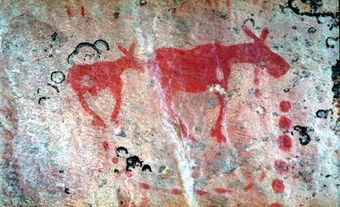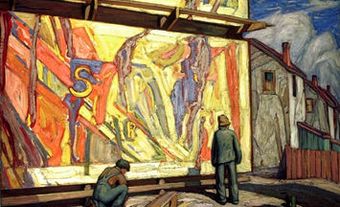
David Bolduc, painter (born 10 February 1945 in Toronto, ON; died 8 April 2010 in Toronto, ON). Heir to the mantle of influential Canadian abstract painters Jack Bush and Gershon Iskowitz. David Bolduc is widely regarded as one of the premier practitioners of abstract painting of his generation. Recipient of solo exhibitions in Canada nearly every year over the course of a career that lasted more than 40 years, Bolduc’s paintings can be found in major collections across Canada, including the National Gallery of Canada, the Art Gallery of Ontario, and the Art Gallery of Alberta. Bolduc was also selected by critic and curator Andrew Hudson for the 14 Canadians exhibit at the Hirshhorn Museum and Sculpture Garden in 1977.
Education and Early Career
Bolduc spent a year at the Ontario College of Art (now the Ontario College of Art and Design University) in Toronto (1962–63), then went on to study with Jean Goguen at the Museum of Fine Arts School in Montréal (1964–65). He received his first solo exhibition in 1966 at the Elysée Theatre in Montréal and also participated in a group show at the Galerie Soixante. Also in 1966 Bolduc moved back to Toronto and took a position in the conservation department at the Royal Ontario Museum, and in 1967 he had the first of eight solo shows at the Carmen Lamanna Gallery. In 1976, Bolduc left the Lamanna Gallery and went to the David Mirvish Gallery.
Bolduc’s early work is tender, playful, lyrical, and reflective, and in that it sharply contrasts with the more aggressive, gestural style of predecessors like Jack Bush. Variable Mix-up (1967), for instance, consists of four square canvases fit together to form a jagged shape and mounted diagonally on the wall, yellow bands outlined in orange against a solid, deep blue ground running through them. High Plane (1968), a work of graphite and collage on wove paper, has a delicate, flesh-pink ground with wavering lines rising to a sketch of folding planes. Gasni (1972) has soft lavender shapes streaked with white washing down onto an earth-tone ground.

Parrot (1976), on the other hand, is one of the paintings that introduced Bolduc’s signature style, and intimated his deeper ambitions: a yellow and white line of pure pigment atop a yellow and red base, situated in the midst of a roiling jungle of green, blue, and red strokes. The idiosyncratic shape at the centre of Parrot, along with the teeming, organic ground, places it on the edge between figurative and abstract painting.
The Traveller
Bolduc was legendary for his passion for travel. As a young man in the early 1960s, he explored the length and breadth of Canada by hopping freight trains. In 1968, funded by a Canada Council Grant, Bolduc took his first trip abroad, an epic, eight-month trek across Europe to Turkey and then overland to Nepal, returning by way of Uzbekistan and Russia. Over the course of his life, Bolduc visited India at least 15 times and repeatedly travelled to North Africa, Turkey, China, the Himalayas, Sri Lanka, Costa Rica, France, Portugal, and Spain. During the mid-1990s, he spent time living and working in Morocco and Paris. And Bolduc always created as he travelled, producing countless works on paper that show the influence of Persian miniatures, Central Asian carpets, Chinese calligraphy, and North African design.

Mature Work
If Bolduc’s earlier work tended toward the decorative, the paintings he began making in the 1980s and continued through the 1990s took on a deeper symbolic significance, reflecting both the influence of his travels and his voracious reading (his close friend Michael Ondaatje once remarked that Bolduc was the best-read person he had ever met). In Knossos (1993), named after an ancient city on the Greek island of Crete, fragile, glimmering yellow lines rise and branch out against a night-black ground, a coiling red flower inside; phosphorescent white stars float by in a fading arc. In the foreground are two dimly lit rows of yellow hatch marks that suggest a shoreline. Tashkent (1993), a work on paper with collage elements, is a diptych named after the ancient capital of Uzbekistan, which Bolduc visited on numerous occasions. In one, a plant form is painted over postcards from the Lenin Museum in Tashkent (now called The History Museum of the People of Uzbekistan), and in the other postcards of Byzantine mosaics in Saint Mark’s Cathedral in Venice and postcards from the Tashkent Lenin Museum are set inside a swarming vortex of blue, a red, coiled eye with blue lashes at its centre. Painted two years after the collapse of the Soviet Union, which Bolduc had experienced during his travels, Tashkent is a meditation on the end of empires, and a lament for the fragility of history.
Illustrations
Bolduc was a lifelong student of modern poetry, and he provided illustrations for numerous volumes of poetry, including Michael Ondaatje’s Handwriting (2000), Roy Kiyooka’s Pear Tree Poems (1987), as well as books by Wayne Clifford, Victor Coleman, and David Rosenberg. Bolduc was also a regular contributor of illustrations for the biannual literary magazine Brick, edited by Michael Ondaatje and his wife, the writer Linda Spalding.
Last Works
In 2009, Bolduc was diagnosed with a terminal brain tumor while spending the summer on Newfoundland’s Avalon Peninsula. During the remaining year of his life, despite the chemotherapy and the advancing disease, Bolduc produced 40 canvases, which, according to critic and friend Gary Michael Dault, amounted to a major creative breakthrough and was some of the best work he had ever made. San Vito (2009), for instance, has a tall, spindly stem woven from strands of color rising up to curling flowers, set against a dense, inlaid, silver forest, two building-like shapes beneath. And in Pilgrim (2010), there is a plant-like shape in orange, blue, red, and white close in the foreground, and behind is a grey band and a glimmering horizon that gives way to a star-streaked night. The strange figure in Pilgrim, a stand-in for Bolduc himself, is on a pilgrimage into the unknown.

 Share on Facebook
Share on Facebook Share on X
Share on X Share by Email
Share by Email Share on Google Classroom
Share on Google Classroom






